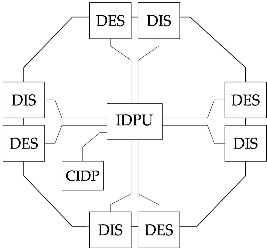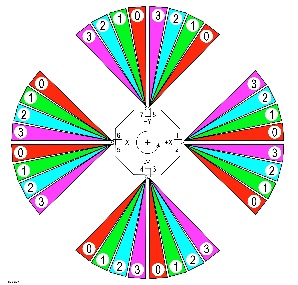The Fast Plasma Investigation measures 3D ion and electron phase space distributions at 150 ms and 30 ms, respectively. This high temporal resolution in 3D phase space measurements is the first in the history of scientific space flight.
Each of the four MMS spacecraft has eight high-speed ion sensors and eight high-speed electron sensors (packaged in pairs as four dual ion spectrometers (DIS) and four dual electron spectrometers (DES)).
These dual spectrometer packages are evenly distributed around the spacecraft perimeter so that full azimuthal sampling of phase space does not depend on the spin of the spacecraft as had been common for previous missions. This allows sampling at speeds limited only by the stepper speeds of the spectrometer high voltage power supplies and the counting statistics possible within the measurement accumulation times. Each group of four dual spectrometers includes twelve independent high voltage power supplies: eight for detector bias and four (each with three outputs) for energy and angle selection,
- MMS3 DIS008 energy sweep limited to maximum of 21 keV.
- MMS4 DES1 (DES210) HV801 optocoupler (ESA high range stepper circuit) failure has left the unit permanently disabled, as of 5Jun2018 12:43 UTC. ref
- MMS4 DES0 (DES215) HV801 optocoupler failure (Deflector0 high range stepper circuit) allows the ESA to sweep the full range of energies at one extreme, uncalibrated deflection angle, as of 15Jul2018 00:49 UTC. This spectrometer has not been in operation since the optocoupler failure. ref
Fields of View: the FPI Skymap
1. Half Polar Angle FOV Configuration:
Each spectrometer is a 180° polar angle top hat mounted so that the 180° fan spans from spacecraft spin axis to anti-spin axis. Each sensor is oriented so that the 16 pixels (each nominally 11.25° wide) of its 180° FOV are viewing radially in velocity space, spanning the 180° pole-to-pole range in the spinning spacecraft reference frame.
A characteristic of the pole-to-pole FOV is that only the equatorial pixels view an extent in spacecraft azimuth equal to their intrinsic pixel resolution. Off-equatorial pixels view a larger range of azimuth due to the cosine effect in the spherical polar coordinate system. The most poleward viewing pixels view a large swath of azimuth, approaching p radians for the rectangular pixels with boundaries at polar angles of 0° and 180°. These effects are accounted for in the results derived from the measurements.
2. Dual Spectrometers at 90˚ spacing
Each spacecraft carries eight FPI electron spectrometers and eight FPI ion spectrometers. These are packaged in pairs in a back-to-back configuration, as dual spectrometers for each species: DES and DIS. Four dual spectrometers for each species are placed around the MMS instrument deck perimeter at 90° intervals. For each dual spectrometer, the two (undeflected) 180° FOV fans are separated by 45° in azimuth.
3. Deflection for Full View of Sky
The FPI spectrometers also incorporate electrostatic FOV deflection, such that center of the azimuth angle FOV of each spectrometer may be deflected in spacecraft azimuth by up to ±16.875°.
In FPI’s Fast Survey mode, each of the eight ion and electron spectrometers samples four azimuths, providing a total 32 azimuthal samples separated by 11.25° for each species. The designations 0, 1, 2, 3 refer to deflector zone definitions; the colors denote common deflection states in the sensor reference frame (i.e., down toward MCP plane or up away from MCP plane).




